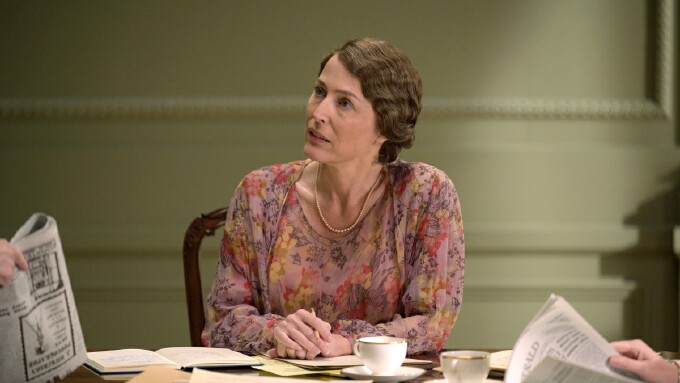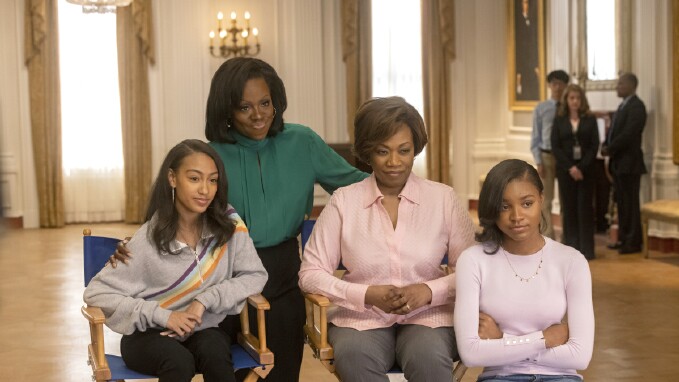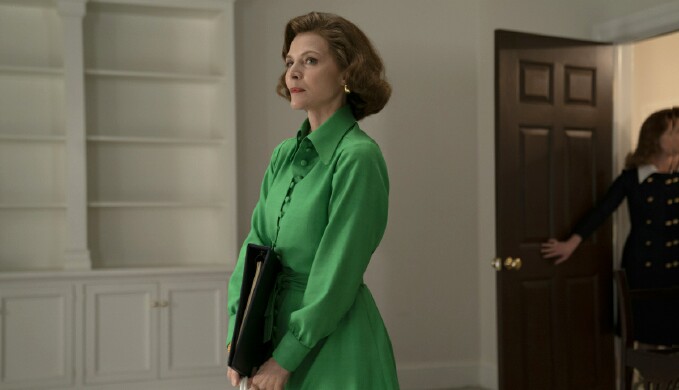Viola Davis, Michelle Pfeiffer and Gillian Anderson on Portraying Formidable Women in Showtime's "The First Lady"

Far more than the power behind the throne, or the chair in the Oval Office, First Ladies Eleanor Roosevelt, Betty Ford and Michelle Obama were powers unto themselves. Yet while they were as independent, intelligent and accomplished as the men they married, they were more interested in forging change than basking in the spotlight. Those dynamics, and a primer on modern American history, are on glorious display in The First Lady, premiering on Showtime Sunday, April 17.
The ten episodes weave the women's disparate lives into a cohesive drama, starring Viola Davis, Gillian Anderson, and Michelle Pfeiffer as Obama, Roosevelt and Ford, respectively. They're shown in flashbacks in similar parts of their lives as feisty teens, and young women determined to make a difference. Viewers are treated to peeks at their courtships, glimpses of their marriages, and their time in the White House. We see them as mothers and on the world stage, but mainly, we see them as fully drawn women.
"We had a very difficult decision to make early on, which was how will we span this many years in three stories with one actor," showrunner, executive producer and writer Cathy Schulman told MediaVillage. "The ultimate decision was to cast in the middle- to upper-end of the age range and to cast their younger selves with ingenue actresses, and the decision was made by a group of middle-aged women. This doesn't sound like a thing to sell it."
And yet it's every reason to watch. Middle-aged women star, direct and produce the epic series offering a vantage of history we should but don't know. Speaking from South Africa, where she was shooting a film with Davis, Schulman -- Oscar-winning co-producer of Crash -- elaborated on the casting.
"When you start with Viola Davis, you need to surround her with people of equal gravitas," she said. "Because the tricky thing about any kind of ensemble filmmaking -- and I've done a lot of this, it's actually been sort of my specialty -- is that the audience would be more interested in one [character] than the other or spend time wishing that they could be in the other story. So, the key was we wanted them to be equally captivating, equally strong."
Viewers will find themselves invested in a plain girl of privilege from New York (Roosevelt) coming of age at the turn of the century. And, they'll be equally intrigued by a Midwestern free spirit (Ford) who taught dance as a child to make money during the Depression. A South Side Chicago teen (Obama) determined to excel at the best schools and become a lawyer in the 1980s also captivates. As different as these women were, they shared deep reservoirs of strength and compassion.

"I wish there were more similar qualities between me and Eleanor Roosevelt, to be honest," Anderson (pictured above) acknowledged during a recent Television Critics Association press conference. "She was an extraordinary human being, and her entire life was about being of service. She lived and breathed duty, and she felt like she had a responsibility well before she got into the White House, the work that she did for the underprivileged. She started a school and, even when Franklin was governor, would send the money that she made to charity. Everything that she did was to be of service for those less fortunate than herself."

Davis acknowledged that portraying Obama was terrifying, especially because, as the most recent first lady featured, people retain strong opinions.
"Everybody has a time period where they loved her hair or hated her hair or loved her eyebrows or hated her eyebrows, and they feel like they own her," Davis (pictured above, second from left) noted.
Considering what struck her about Obama, Davis said, "her height … but also ‑‑ I don't want to say confidence because that's almost reductive ‑‑ but her sense of worth, her sense of belonging, that seemed like a rooted oak tree."

Each First Lady meets challenges head-on. Pfeiffer radiates Ford's warmth and sense of fun, happy to knock back a drink and take a spin on the dance floor. When Ford had a mastectomy, she spurred thousands of women to get mammograms. When she talked frankly about quitting drinking and kicking painkillers, it encouraged others to seek help. Before Ford, people whispered about these subjects, yet she put on a fabulous outfit and faced the cameras.
"It's one thing to be brave in the privacy of your own circumstances," Pfeiffer said. "Betty Ford did it in front of the whole world and still managed to be fearless, frank and kind. For millions of women across this country, she wrote a new chapter of American history practically on a daily basis, shedding light on many issues no First Lady had ever acknowledged, challenges that affected thousands of people while being utterly taboo to discuss."
While the focus is on the First Ladies, the presidents naturally play important roles, with Kiefer Sutherland as FDR, Aaron Eckhart as Gerald Ford, and O-T Fagbenle as Barack Obama. The cast includes Ellen Burstyn as FDR's disapproving (of Eleanor anyway) mother; Regina Taylor as Michele's mom, Marian Robinson; Lily Rabe as Hick, a reporter who was Eleanor's lover, and Dakota Fanning as daughter Susan Ford.
Executive producer and director Susanne Bier, with a background in design and architecture, used the White House as the series' continuity thread. Each woman made it her own, yet it retains the constancy of history as the first ladies walk through legendary rooms.
"Part of the First Lady's mission is to redecorate the house, which, for example, for Eleanor was not a particularly pleasurable endeavor," Bier said. "So, there is this expectation of shaping the space into one's own taste. We were very keen on being very personal and being very loyal to each First Lady in terms of what all of the visuals were like."
While these visuals perfectly reflect the clothes, cars and furnishings of their times, the tone captures how foolish people tried to censor these women. Each administration had political functionaries deluded enough to think that they could stifle First Ladies.
"I was most fascinated by the march of time," Schulman shared. "And the march to find their voice as women, and the constant sublimation of [their] voices and the sort of unanimity with which these women ultimately had to find their way through this sort of patriarchal morass."
A scene in the fifth episode illustrates this beautifully.
"As press secretary, all events in this house go through me," a blowhard tells Eleanor about a press conference she wanted for women reporters. "This idea reveals a clear, basic misunderstanding of your role in this house."
Unblinking, Eleanor replies: "The role of the First Lady has never officially been defined or codified."
"But the expectations have, by time and practice," he retorts. "I cannot allow this."
Telling these women what they are allowed to do is not only futile; it's a dare. A scene with only women reporters at a press conference follows.
While the season showcases these three First Ladies, Schulman acknowledged her goal.
"I guess the binding thing was, where do you start an anthology series that you hope will go on many, many years and deal with all of the women?" Schulman said. "I hope we'll get through all of them -- if we count Melania, anyway."
The First Lady is telecast Sundays at 9 p.m. on Showtime.
Click the social buttons to share this content with your friends and colleagues.
The opinions and points of view expressed in this content are exclusively the views of the author and/or subject(s) and do not necessarily represent the views of MediaVillage.com/MyersBizNet, Inc. management or associated writers.


